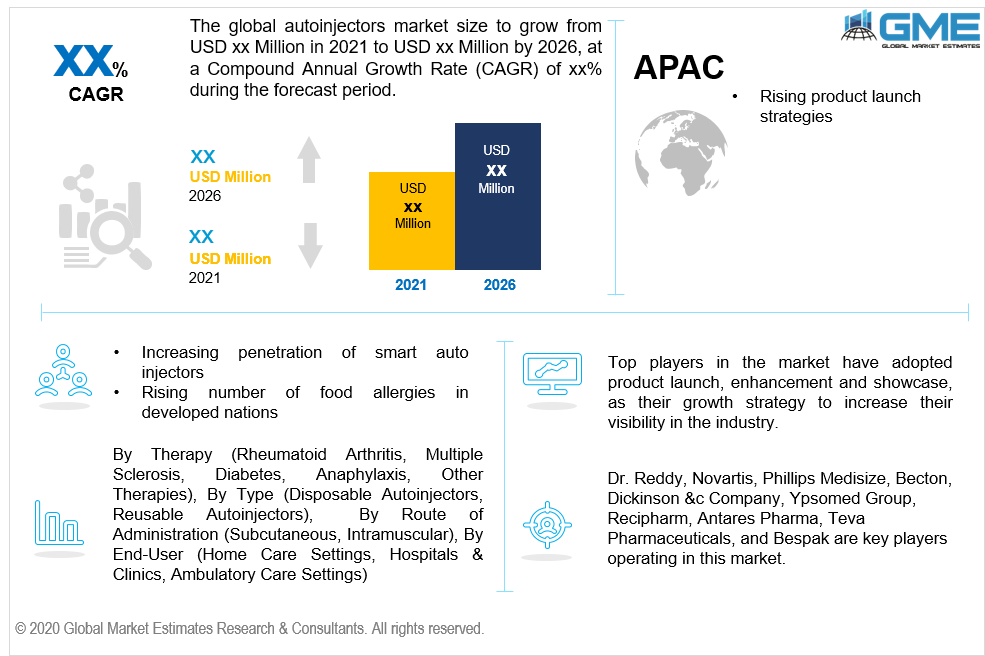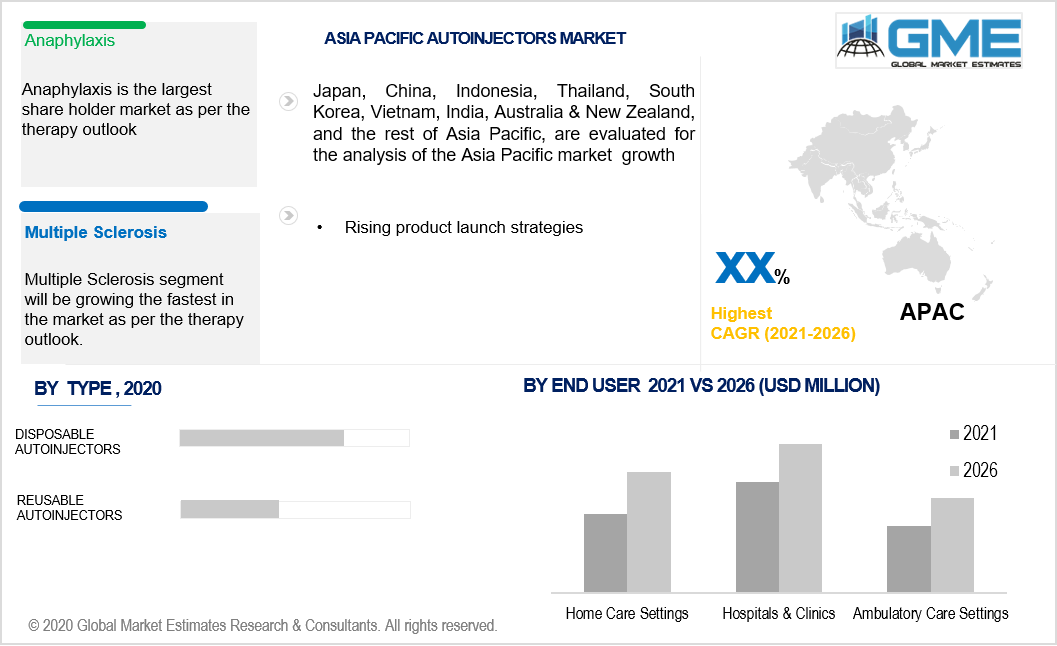
Global Autoinjectors Market Size, Trends & Analysis - Forecasts to 2026 By Therapy (Rheumatoid Arthritis, Multiple Sclerosis, Diabetes, Anaphylaxis, Other Therapies), By Type (Disposable Autoinjectors, Reusable Autoinjectors), By Route of Administration (Subcutaneous, Intramuscular), By End-User (Home Care Settings, Hospitals & Clinics, Ambulatory Care Settings), By Region (North America, Asia Pacific, Europe, Central & South America, Middle East & Africa); End-User Landscape, Company Market Share Analysis, and Competitor Analysis
Drug delivery is a critical approach in the healthcare sector to ensure the therapeutic agents and specific drugs reach the targeted body parts. Another important approach is the devices that ensure effective drug delivery called autoinjectors. Autoinjectors were designed to meet the rapid drug delivery and immediate medication needs. Such devices are designed for individuals not fully medically trained which enhances the drug delivery mechanism in case of emergencies and casualty.
The device’s presence in the market has been celebrated across pharmaceutical verticals since the early 2000s. The penetration of the autoinjectors for the treatment of anaphylaxis marked the large-scale use of the device. The device has a mature market in European nations and the USA with the support of the regulatory bodies. The device’s increased visibility in Europe and the USA is the result of at least 20 combinations available of the autoinjectors.
Their use and importance are advocated for people vulnerable to allergies. The delivery of epinephrine by using autoinjectors can help to stabilize low blood pressure and improve breathing and also lower the swelling in the case of extreme allergies. Rising cases of allergies are visible in the USA and England. The admissions to the hospital in England increased multifold (2013-2019) as the incidence of anaphylaxis rose in children.
The much use of the autoinjectors has been linked to the reliability and simplicity these devices offer without any physician’s aid. The device efficacy is enhanced by the instruments that test them and the constant up-gradation in the testing instruments also bears positively on the autoinjector’s use. Few technologies revamping the market space are automated solutions and coherent sensors. The ever-increasing exploitation and affordability of autoinjectors have also exceeded the use of hypodermic needles.
The market is developing at a faster rate with companies developing sound and advanced technologies to treat chronic diseases. Other drivers that are also contributing to the market demand are the rising number of therapies to cure chronic diseases.
Manufacturing companies of autoinjectors are seeking out opportunities to invest in and develop platforms that can handle multiple drugs. Syrina Platform is one such technology that supports the injection of high doses and viscosity products. The introduction of the powered form platform is enhancing the market space and capacity. Vapoursoft is one such powered platform that caters to the drug manufacturer’s needs and enables altering the device according to the therapy needs.
The growing positive change in the market is addressed by the introduction of new smart technologies that enhance the constant injection rate. Smart is everywhere and smart autoinjectors are having a sizeable impact on the market in general. Smart autoinjectors are developed to meet the pharmaceutical company’s needs and to better serve the customers growing needs. Europe widely celebrates the use of smart autoinjectors and their use in the USA market is also widely accepted. The market’s growth and pool of opportunities increase through the webinars conducted on the acceptance of smart autoinjectors in the healthcare space. SmartPilot –a smart autoinjector is equipped with Bluetooth connectivity to effectively track the injection time and date. Other added features include are no charging of the product throughout its shelf life.
The collaboration among companies of smarts systems and injection systems also boosts the use of smart autoinjectors in the pharmaceutical space. The growing patients’ need for higher doses has also led to the introduction of autoinjectors that can administer up to 2.25 ml of drugs.
Aggressive launch strategies in Europe are commercializing the market sphere for autoinjectors leading the manufacturers to showcase their product on a wide scale. Bespak in 2015 introduced the Syrina 2.25 in the European market. The market’s growth opportunities are also addressed by the workshops led by industry players on the importance of self-administration and innovation in the autoinjectors.

The anaphylaxis segment would assert a higher use of the autoinjectors. The wide use of adrenaline autoinjectors for the treatment of extreme allergies (anaphylaxis) would place the segment on a competitive front. As life-threatening diseases rise in the industrially developed regions, the use of auto-injectors is widely prescribed.
Multiple sclerosis treatment through the use of autoinjectors is gaining wide-scale recognition. Pharmaceutical companies streamlined surveys and the latest data findings point towards the rising preference for autoinjectors among nurses and patients of multiple sclerosis.
The Disposable type dominant position and persistent use in the market is addressed by the aggressive launch strategies adopted by the manufacturers of disposable autoinjectors. The disposable autoinjectors offer the patients usability and safety benefits as compared to the reusable type. These devices are prevalent in emergency therapies and are experiencing constant technological advancements.
Subcutaneous injection is trending in the administration of the drug industry. This route type is effective in the delivery of vaccines and insulin that require continuous administration.
Hospitals and Clinics dominating presence would be supported by the collaborative efforts of manufacturers in partnering with the clinics and the wide availability of autoinjectors in the hospital space.
Home care settings in the recent past observed a rising trend as patient’s need for home use autoinjectors increased multifold. Autoinjectors for asthmatic patients are developed to be used in the home care space. Home care settings in European countries are also widely recognized to implement effective care and strategies.

North America’s sustained growth and dominating presence are supported by the diverse type of autoinjectors available in countries such as the USA and also due to the rising incidence of food allergies in the USA.
The Asia Pacific is experiencing a growing need for advanced autoinjectors and also rising penetration of autoinjectors in the Indian market. The increasing launch efforts by manufacturers operating in this region are visible in the foreign markets as well. Manufacturers in this region are showcasing their products in the USA and Indian markets.
Dr. Reddy, Novartis, Phillips Medisize, Becton, Dickinson &c Company, Ypsomed Group, Recipharm, Antares Pharma, Teva Pharmaceuticals, and Bespak are key players operating in this market.
Please note: This is not an exhaustive list of companies profiled in the report.
In March 2020, Teva launched an autoinjector-AJOY to treat migraines.
In October 2019, Becton, Dickinson &Company launched the new two-step disposable autoinjectors.
We value your investment and offer free customization with every report to fulfil your exact research needs.
The Global Autoinjectors Market has been studied from the year 2019 till 2026. However, the CAGR provided in the report is from the year 2021 to 2026. The research methodology involved three stages: Desk research, Primary research, and Analysis & Output from the entire research process.

The desk research involved a robust background study which meant referring to paid and unpaid databases to understand the market dynamics; mapping contracts from press releases; identifying the key players in the market, studying their product portfolio, competition level, annual reports/SEC filings & investor presentations; and learning the demand and supply-side analysis for the Autoinjectors Market.

The primary research activity included telephonic conversations with more than 50 tier 1 industry consultants, distributors, and end-use product manufacturers.

Finally, based on the above thorough research process, an in-depth analysis was carried out considering the following aspects: market attractiveness, current & future market trends, market share analysis, SWOT analysis of the company and customer analytics.

Tailor made solutions just for you
80% of our clients seek made-to-order reports. How do you want us to tailor yours?
OUR CLIENTS